MiGs, Stars & Magic Books: A Brief History of Trespassing in Moscow
An illustrated guide to urban exploration in the Russian capital.
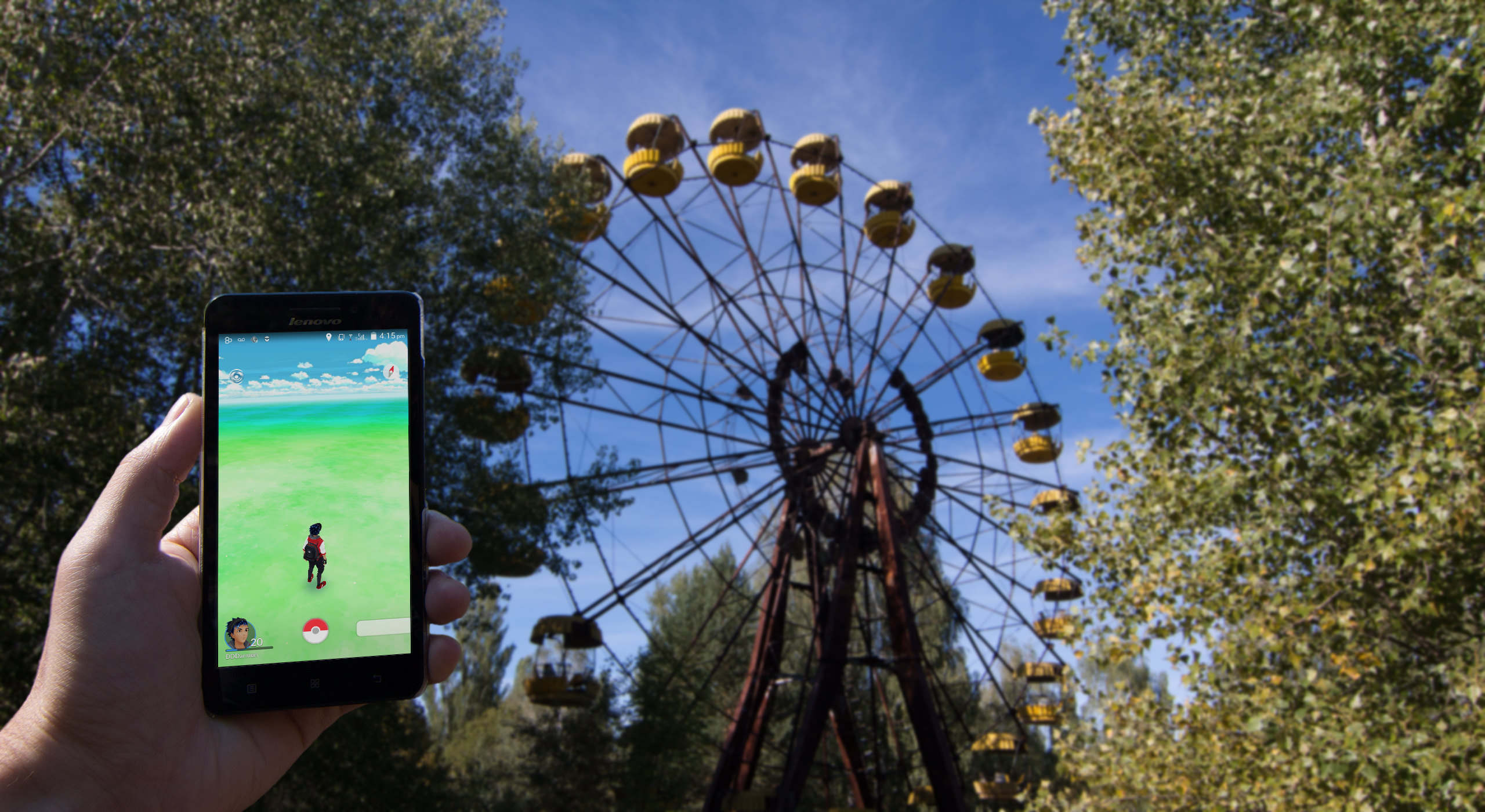
30 November 2016
The clock hit midnight and our eyes met. Here the courtyard rang with the sound of traffic, carried above the houses from beyond: where sports cars raced each other down the six-lane tarmac of Lesi Ukrainky Boulevard and buskers played gypsy jazz to the crowds spilling out of late-night bars. Kyiv is a city of contrasts, and it doesn’t have an Off switch. Nothing moved in the courtyard though – not even the stranger who had followed me here, his silhouette framed in the arch between the houses.
The streetlight flickered once, twice, then died. Darkness swallowed the stranger, and when the lights returned he’d disappeared. For a moment I was alone and then a sudden movement caught my eye, and I saw him again – lurking behind the bins now, his hooded face lit from beneath by the pale blue light in his hands. I realised, suddenly, that we had come here for the same thing. My phone buzzed in my hand and our mutual target revealed itself: a wild Pikachu had appeared.
When Pokémon Go took the world by storm in the summer of 2016, it represented more than just a mobile gaming trend: it heralded the widespread arrival of augmented reality gaming. Suddenly, any real world map could be transformed into a playable gamescape… but the gamification of urban geography is fraught with problems, both practical and ethical.

Back in the summer, when the game’s popularity was at its peak, I read stories in the press that highlighted some of these issues. In July, a New Jersey homeowner filed a lawsuit against the game’s creators – Niantic, Inc. – for allowing monsters to spawn in his backyard, thus enticing wave after wave of trespassers onto the property. Meanwhile, the Washington, D.C. Holocaust Museum was imploring its visitors to refrain from catching pokémon on the premises.
It was stories like these that made me start to pay attention… I was curious to see how the game mapped itself onto reality, and how it chose its locations. I wanted to understand the spatial politics of augmented reality; and so I played Pokémon Go for three weeks, as I travelled the length of Bulgaria and then flew to Kyiv, Ukraine, on my way to the Chernobyl Exclusion Zone.

Pokémon Go encourages movement. The gameplay depends on it, in fact – there’s very little you can do with it while sitting down. I was constantly on the move that first week though, and I built a lot of in-game experience just by idly tapping at the screen as I went about my route.
The game seemed well established in Varna, displaying a map of the city decorated with dozens of pokéstops (treasure chests) and gyms (where players send their creatures into battle). The cathedral was a gym, there were pokéstops scattered along the beach, while invisible pixel-monsters roamed throughout the city centre. Playing the game felt like looking through x-ray glasses, with familiar places reimagined as virtual landmarks. Meanwhile, I watched a war rage across the city – red, yellow and blue teams fighting for control of significant locations – a heated conflict, invisible to all but the initiated.

Almost every noteworthy landmark I passed on foot (monuments, museums, schools, cemeteries and fountains) commanded real estate in the game, and would appear on the map with some celestial symbol dangling over it. The game drew my attention to details of my surroundings that, often, I’d never really looked at before. Sometimes, I could even tap the icon to get a screenful of information about the place.
Back in 2011, on my first visit to Varna, I took a free walking tour of the city that stopped at all the usual guidebook attractions. Pokémon Go went further, though: it didn’t just point out statues, churches and Roman ruins, but it directed me to more abstract highlights too. Political graffiti, architectural oddities, and even some non-places that felt nevertheless imbued with a sense of atmospheric tension. The curious, the colourful, the accidental and the odd; the unlikely details that give a city soul, the textures that make a country more than the sum of its UNESCO sites.

For my tastes at least, Pokémon Go offered the superior tour of Varna… and it achieved this by paying attention to the psychogeographical currents of the city.
The concept of psychogeography is usually credited to a group of avant-garde spatial philosophers in post-WWII Paris. Guy Debord, a co-founder of the ‘Situationist International,’ proposed psychogeography as: “the study of the precise laws and specific effects of the geographical environment, whether consciously organised or not, on the emotions and behaviour of individuals.”
In practical terms, it offered a new way of understanding the urban environment. Maps, Debord explained, depicted the city from an impossible angle – a bird’s eye view – which gave very little indication as to the atmosphere, the soul, of the place they described. Instead, the Situationist International experimented with their own maps of the city: fluid diagrams and flow-charts that sought to illustrate what Debord called, “psychogeographical contours … constant currents, fixed points and vortexes”.

Those early psychogeographers used the word ‘dérive’ (from the French for ‘drift’) to describe this form of immersive, feeling-driven interaction with the city. The rules of the dérive, according to Debord, were that: “one or more persons during a certain period drop their usual motives for movement and action, their relations, their work and leisure activities, and let themselves be drawn by the attractions of the terrain and the encounters they find there.”
Another former member of the Situationist International, Ralph Rumney, put it this way: “the essential thing was to set out with very little purpose and to see where your feet led you, or your inclinations… You go where whim leads you, and you discover parts of cities, or come to appreciate them…”

Playing Pokémon Go in Varna, Bulgaria, I would increasingly find myself drawn into new and unfamiliar urban areas. Whether I was chasing after the fantastical creatures visible only through the magic lens of my smartphone screen, or following glowing symbols to find a treasure stash secreted behind a shop sign, a roundabout or a wall of graffiti; in these moments I had dropped my usual motives for movement and action, to be drawn by the (virtual) attractions of the (physical) terrain, and the encounters (with imaginary monsters) that I found there.
I wonder what those French philosophers would have made of Pokémon Go. The game encourages a playful, abstract mode of interaction with public space; drifting without purpose, feeling for invisible vibrations on the virtual plain. It has players walking miles through unknown terrain to reach a mere scribble of graffiti, the kind of details that most people would pass without ever seeing. All of this feels profoundly psychogeographical.
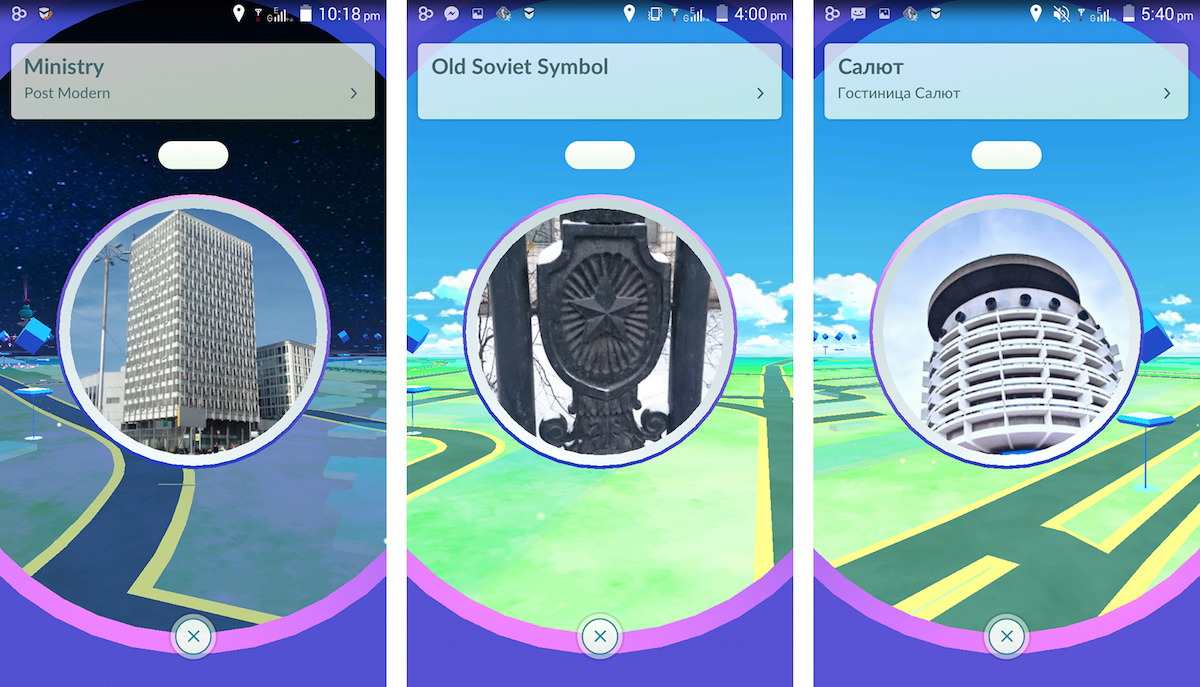
But there was also a political aspect inherent to the early psychogeography, a Marxist meta-commentary on the appropriation of public space; with the dérive itself functioning as a kind of shambling, wilfully aimless revolt against the ‘rat race,’ against the prescriptive routines and perceived soullessness of advanced capitalist society: what Debord called the ‘Society of the Spectacle.’
It was fascinating then, to discover that Pokémon Go also makes its own inadvertently political statements about the physical world it augments.
Hunting for pokémon around Bulgaria, I soon began to notice the politics – or rather, the jarring indifference to sensitive political subjects – that seemed to inform the selection of in-game locations.
The Park-Monument to the Bulgarian-Soviet Friendship looms on the edge of Varna: a majestic concrete bird opened in 1978 to celebrate a political relationship that would be dead within a decade. Now the monument stands abandoned on its hill like an oversized corpse, and many locals consider the place an eyesore (as you’d guess, it doesn’t get a mention on the free walking tour).

The first time I visited the monument, it was against the advice of my local friends. “It’s just some old Russian rubbish,” one told me, and suggested I stayed well away from the place. This time around though, I was lured back to the brutalist monument by flashing icons and the promise of a poké-gym.
Bulgaria has not been as quick as some other formerly-communist states to reconcile the artefacts of its past. Local tourism agencies direct visitors away from places of communist heritage, while there have been many national efforts to suppress or destroy physical remnants of the period. In 1999, the Bulgarian government levelled the mausoleum of communist leader Georgi Dimitrov using bulldozers and TNT; there was controversy and fierce opposition when a Museum of Socialist Art was opened in Sofia in 2013; meanwhile, the abandoned Buzludzha Monument stands as perhaps the ultimate symbol of unique heritage gone to ruin.
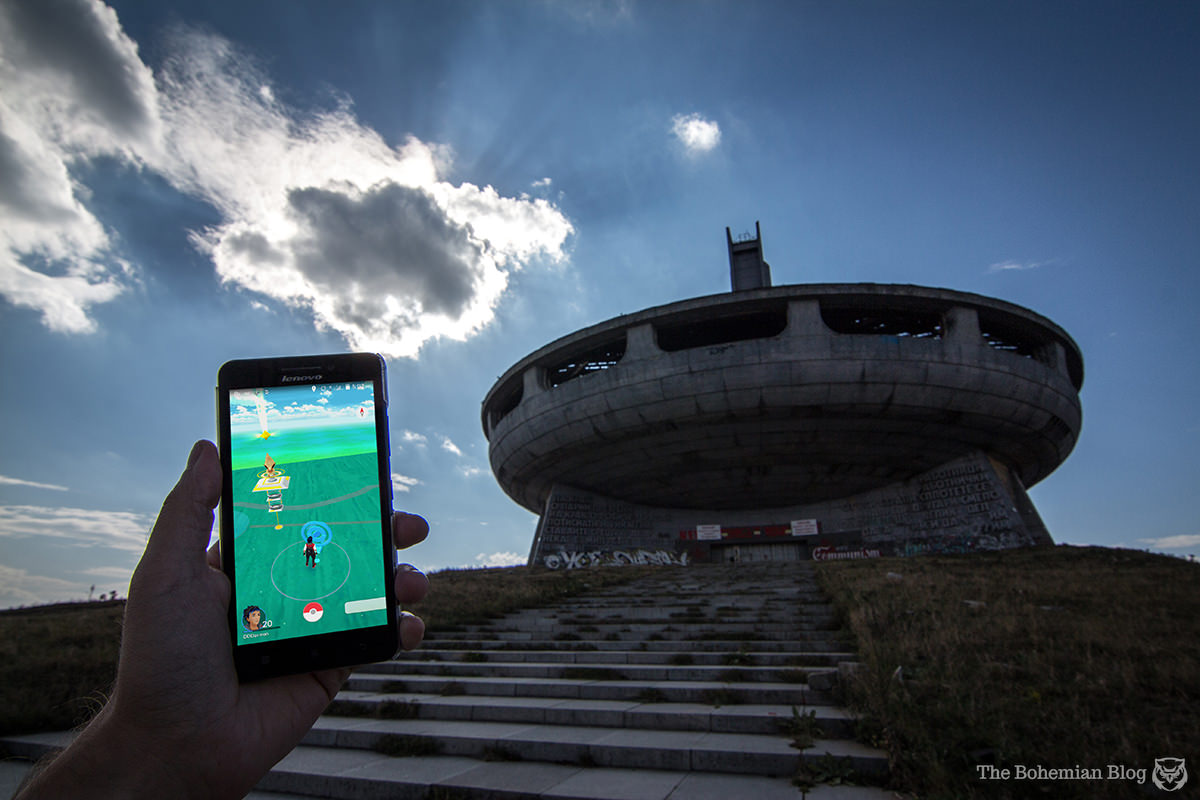

Today, the Buzludzha Memorial Complex features two gyms and two pokéstops. It’s a busy place, virtually speaking – I captured the gym as soon as I arrived, and by the time I left it was being fought over by two subsequent challengers.
That week, I travelled 2,600 km around Bulgaria and stopped off at 24 communist-era monuments along the way. They had all found their way into the game as playable locations… even the Arch of Liberty, a mountaintop monument hiding in the clouds at an altitude of 1,520 m.

All of this made me very curious as to how in-game locations were chosen, and so I did some research. Before creating Pokémon Go, the developers at Niantic had worked on another augmented reality game, called Ingress. Released in 2012, Ingress features rival teams fighting for control of in-game markers tied to real-world locations. These ‘portals,’ as they call them, were crowdsourced: up until September 2015, players could simply submit any location that seemed significant. Pokémon Go seems to have inherited those same maps.
I was starting to sense a deeper level of resonance between Pokémon Go, and the avant-garde philosophy of the early psychogeographers. All location data in the game had been gathered from the bottom up, a virtual territory grown from the phenomenological experiences of its players in the field: an exercise in gestalt world-building. Free from censorship, this map presented a democratised report on the country’s varied psychogeographical textures.


Gardens and museums, ruins and graffiti; gold-roofed monasteries and Soviet relics, all given equal weight. It made me wonder, more than ever, how the Chernobyl Exclusion Zone was going to look through the lens of augmented reality.
If Pokémon Go had seemed popular in Varna, it was nothing compared to what I encountered in Kyiv. There were far more creatures appearing on my map here, more in-game locations, and more players too. By now I had become an expert at spotting them: it takes one to know one, I guess.
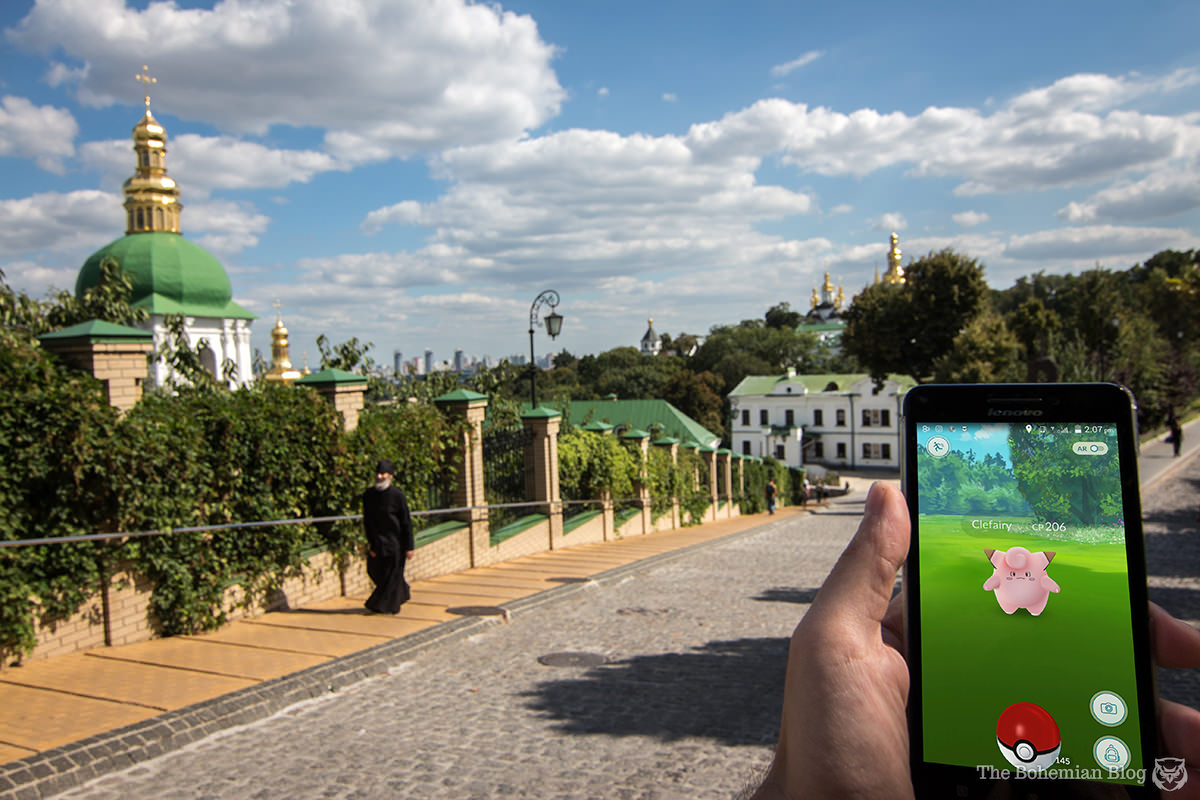

When I wasn’t running into furtive hunters on late-night safaris through the backstreets and courtyards of Kyiv, I was encountering them in parks, cafés and train stations. At night, the blue glow of the map screen lit downturned faces in bus stops throughout the Ukrainian capital. Other times I was able to track players by their in-game actions; like the woman who’d taken her children to visit the monastery at Kyiv Pechersk Lavra, then triggered a pokémon lure as she sat and waited for them outside. (If you had assumed that Pokémon Go was played exclusively by youngsters, you’d be very wrong.)
With a few days to kill before my trip to Chernobyl, I spent much of my time just wandering – engaging in digital psychogeography around Kyiv. I wasn’t particularly fussed about catching anything, but rather I was curious to see where the game would lead me.

As had been the case in Bulgaria, all the major landmarks of Kyiv were represented in the game… but it was the details, the textures and abstract “units of ambience” (to quote Debord again), that really brought the digitised city to life. The game led me from the imperious Motherland Monument down to the river, then through parks and into twisting networks of residential streets; along the way pointing out a list of attractions that included a headless shop window mannequin, a faded cat mural, the earth-filled entrance to a bomb shelter and a Soviet-era hotel built in the brutalist style. It made for a delightfully eccentric tour.
In 2015 Ukraine passed new laws that effectively criminalised the use of communist symbols… however, it seemed that Niantic hadn’t got the memo. The Pokémon Go map of Kyiv was littered with hammers and sickles; with stars, fists, tanks and eternal flames.

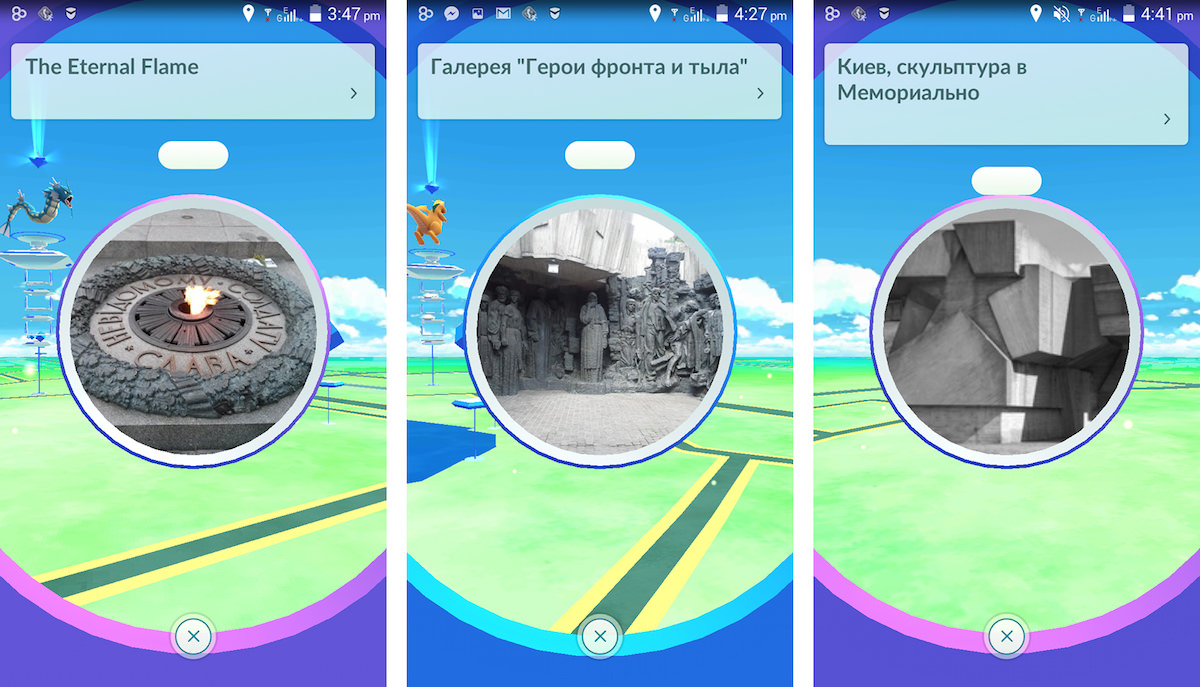
Once again, the selection of playable locations here was presented entirely without political bias or censorship. It was refreshing, for the most part… but there were occasions, however, when I would sometimes wonder if perhaps the game had crossed a line: and inadvertently strayed into the realms of bad taste.
With a population of some 4 million people, Kyiv is not a small city. It’s large enough that Pokémon Go classes it as a collection of distinct subregions, and as I walked from one to the next the game seemed to be making direct comments on my surroundings. The monastery complex for example, with its catacombs, belfries and spires, was chiefly inhabited by bat- and fairy-type pokémon. There were ducks and turtles at the river’s edge, rabbit-like creatures in the park. Walking through the Pechersk Industrial Zone, meanwhile, I was inundated with poison-type pokémon.
At Maidan Nezalezhnosti (Independence Square), I saw three rare fighter-type pokémon in my first ten minutes alone. Only 18 months previously this place had witnessed open combat during the 2014 Ukrainian Revolution – fists and bombs and sniper fire – and it made me uncomfortable to think that perhaps the game was making a reference to real world events.


Of course, it could have been a coincidence. Just like it may have been coincidental that the cemetery at the Park of Memory was full of pokémon resembling worms and moles and ghosts. In the heart of the cemetery, the modernist Kyiv Crematorium was itself a training gym.
I had noticed something similarly distressing in Bulgaria, when I visited the town of Batak: the site of a nightmarish massacre in 1876, when Ottoman forces had tortured and killed thousands of Bulgarian victims. After the massacre, the polished skulls and bones of the deceased were put on display at the church where they’d made their last stand. Now, that same massacre memorial is a pokéstop, dispensing in-game items and power-ups to passing players.


Kyiv’s own Holodomor Memorial – remembering the death-by-starvation of roughly 2.5 million Ukrainians from 1932-33 – has also been added to the map, as a playable location in Pokémon Go. A sign pinned outside the Holodomor Museum reads: “At the memorial it is forbidden to play games! Please, have respect for memorial sites and teach this to your children!” Above the text appears a pokémon character, crossed through with a red line.
What the museum’s curators perhaps didn’t realise, is that it’s possible to request for certain locations to be excluded from the game (although it seems the company aren’t always quick to respond). That’s what the Washington, D.C. Holocaust Museum eventually did – just as various former concentration camps such as Auschwitz and Dachau have likewise decided to opt out. I found what I suspected to be one of these Pokémon ‘no-play zones’ just outside Kyiv: at the Mezhyhirya Residence, the one-time home of exiled former president, Viktor Yanukovych.

Yanukovych fled Ukraine during the revolution, after which his 350-acre estate was reclaimed and turned into a park – the tyrant’s classic car collection is now an automobile museum, his private roads have become cycle paths, and so on. Around the estate, and particularly along the waterfront where locals relax in newly-built bars and cafés, Pokémon Go has an active presence and various in-game locations to interact with. However the residence itself, now a museum and ostensibly the focal point of the whole estate, has absolutely nothing going on: nothing spawns there, and there are no items to collect; it remains a place of reflection amidst the larger recreational complex, and I don’t think that’s an accident.
It didn’t bode well for my Chernobyl safari though; nor did the discovery of an article about Fukushima, explaining how Tepco (Tokyo Electric Power Company Holdings Co.) had managed to get the Japanese power plant removed from the game for fear of luring players into radiation hot-spots.
In the end, in all honesty, I went to Chernobyl expecting a no-show… but I was in for a surprise.

The Chernobyl Exclusion Zone consists of two separate areas, one inside the other. The ‘10km Zone’ is the most secure (and radioactive) region, including all land within a 10km radius of the ill-fated Reactor 4. It includes the offline Reactors 1-3, the unfinished Reactors 5 and 6, an active canteen used by workers at the Chernobyl NPP complex as well as the abandoned city of Pripyat. Around that, the ‘30km Zone’ is a less irradiated area which remains home to around 800 people.
We were heading straight for the heart of the Exclusion Zone when our bus broke down.
At the entrance to the 10km Zone, we stopped to show our passports to the military guards. Clambering back onto the vehicle after, we made it another few metres past the checkpoint before the bus began spluttering, stalled, and then completely failed to start again.

Stranded in one of the most radioactive places on the planet, sitting on the ground was not an option. Instead we stood around awkwardly as we waited for a new bus: and I decided to fire up Pokémon Go to see what was about.
“No recent sightings,” the app told me, over an empty void of green.
Rescue came in the form a police minivan. We hitched a lift to the reactor with the Chernobyl security forces – eight people squashed into a rattling machine – and soon enough we arrived at the Chernobyl Nuclear Power Plant. There were still no sightings… no pokéstops, no gyms, no in-game activity whatsoever in this area. We visited the staff canteen that afternoon; we saw Reactor 5 and its cooling tower, stopped off at the old radiological lab on the waterfront, but nothing.
I concluded – prematurely – that the whole Chernobyl region would be unplayable; but in the outer 30km Zone, that theory was soon proven wrong.

Our accommodation for the night was in the town of Chornobyl, from which the reactors – and the region – take their name (see my note on names, at the bottom). Located inside the relatively safe 30km Zone, Chornobyl is a functioning town complete with two hotels, a shop, a bar, a police station, and seven hundred residents scattered between several thousand homes.
I loaded up the game that evening, and suddenly the map began to populate with a forest of pokéstops and gyms. The first actual pokémon I sighted (a Weedle, for anyone who cares) appeared inside my room at the Hotel Pripyat. Shortly after that I caught another (a Pidgey) at the Chornobyl town shop. It was business as usual.


By midnight, our group was sat with bottles of vodka and beer around the stone feet of Vladimir Lenin. Following Ukraine’s recent campaign of deSovietisation, this was one of the last remaining Lenins in the country; and in the game it appeared as a pokéstop.
Later I decided to go for a wander on my own, exploring the town with glowing smartphone in hand. The streets were quiet, and the darkness was absolute. I stumbled a few times, tripping blindly on uneven pavements and the gnarled roots of trees that popped at intervals out of the tarmac like the writhing bodies of sea serpents. There were digital creatures all around me, ripe for the catching – it was as busy a playing field as any I had yet encountered.
A few minutes later the veil of darkness before me parted: I passed through a knot of trees, and ahead rose an angel cast in silhouette against the stars.

The ‘Third Angel’ monument in Chornobyl features in Pokémon Go as a gym. I decided to capture it, and sent my pixellated troops into battle. After a few attempts the angel was mine.
I tried walking back to the group after that… I aimed for what I assumed was the path, running down the side of the road through the centre of Chornobyl, back to the police station and then to the Lenin monument beyond. After a few minutes of cautious shuffling however, I bumped into a brick wall; somehow I’d crossed the road by mistake, and hit the buildings on the other side. I tried aiming again – pure guesswork now – and started to walk.

I was in open space with a hard surface underfoot, which I took to be the road. After that, I felt trees – so I groped my way from one to the next, through the thicket… until eventually I emerged into the same clearing, back at the angel again. Full circle.
Pulling out my phone to check the time, I had another quick look at the game: the angel was gone. Captured by another player. I had only held it for 10 minutes, before being ousted – which meant that there was another player, right here, somewhere, with me in the darkness. I quickly glanced around, but it was pointless. All I could see were black shapes rising from a black void, the outlines of treetops brushing an infinity of stars.
The next morning we were heading into Pripyat: the abandoned workers’ city in the heart of the 10km Zone. Before we left, I checked the angel. It had changed hands again overnight, and I wondered how many virtual battles had raged there in the darkness.
Driving to Pripyat with our replacement bus and driver, we passed the famous signpost near the reactors: “Pripyat 1970,” it read, pointing the way to the ghost city. And that’s where my GPS signal cut out.

Pokemon Go requires both wireless Internet and GPS to function; the satellite signal positions you on the map, while the wifi fills it with items to interact with. I had a perfectly solid Internet connection – I even sent and received a few emails from Pripyat itself – but for most of that day, my map was frozen. My in-game avatar paced aimlessly on the spot, at a crossroads near the Pripyat sign, while a message on the screen warned, “GPS signal not found.”
I tried restarting my phone, several times, to no avail. There could have been a GPS jammer in the vicinity, I reasoned – they’ve been employed in recent years to disable drones flying too close to power stations, or to prevent them from making deliveries to prisons. But why a GPS signal would be blocked for the ghost town – yet operate perfectly at the high security power plant complex – made no sense.
Logical or not, the GPS blight was at least consistent; and so I resigned myself to marking Pripyat as a no-play zone.

Driving back out that evening, my avatar was still waiting for us by the Pripyat sign. It paced on the spot until we caught up, then the error sign disappeared and the little character glitched and jolted down the road as it ran to keep up with the bus.
I stopped playing Pokemon Go three weeks after I started. The game itself didn’t enthral me – I had no desire to catch them all – and besides, I had already got what I came for.
For starters, I had an answer to my big question: Yes, there are pokémon inside the Chernobyl Exclusion Zone, but only in the inhabited 30km Zone. Inside the 10km Zone the game shows nothing, and there may even be a GPS jammer in operation in some areas.
More interesting in the end though, were the discoveries I made along the way: and in particular, the emergence of two themes which would come to dominate my experience of the game.
I found it bizarre how closely Pokémon Go seems to echo the ethos of the 1950s Parisian avant-garde… with locations sometimes picked for no bigger reason than their textural value, or atmosphere. The game gets people moving, exploring, and it led me to some wonderfully abstract places; discrete urban delights that I would otherwise have missed. Even without catching the in-game creatures, the platform facilitates an interesting and original form of tourism.
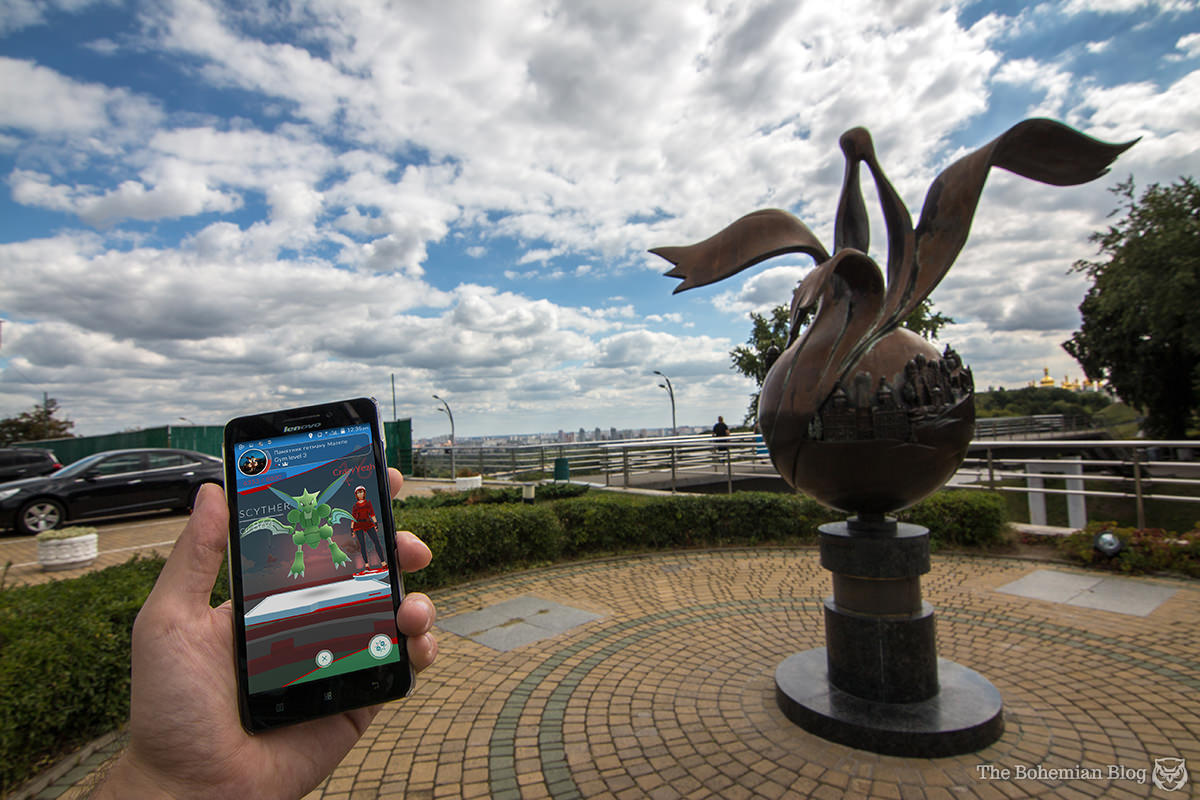
The game’s system of world-building had the effect of stripping away politics from what included some highly contested sites. It broke taboos, and valued objects of communist heritage with equal weight to more conventional attractions. If this is the start of a new trend in gaming – if future generations are to grow up experiencing the world through similar platforms – then it hints at a growing cultural shift towards the depoliticisation of 20th century ideological architecture, even in countries where that history is still now a subject of division.
There were times however, when this separation of place and meaning proved problematic. While political art may be open to debate and interpretation, concentration camps are not. There are some places where it’s just not okay to play games. Including these sites in the game by default then, doesn’t feel particularly appropriate.
Perhaps future augmented reality games might offer different modes of interaction at different sites; encouraging play in the presence of street art, for example, while simply providing educational resources at other locations. Who knows where it’ll go from here. But while Pokémon Go might be slowing down after its initial summer of madness, the augmented reality platform is only warming up… and I’ll be curious to see what comes next.

A Note on Names:
There is currently a lot of debate surrounding the use of Ukrainian place names in foreign media. (The Calvert Journal explain it in more depth than I plan to here.) Traditionally, English speakers have used Russian versions (i.e. ‘Kiev’), though recently there has been a renewed effort by the Ukrainian government to encourage the international use of Ukrainian forms (i.e. ‘Kyiv’). In this article I have chosen to use Ukrainian names for places where Ukrainian communities live (Kyiv and Chornobyl), but I have kept Russian forms for Pripyat and Chernobyl NPP / Zone, places which in many ways were frozen in time while the area was still governed from Moscow.
A Note on Photographs:
Usually I prefer to keep photo editing to a minimum, in the interest of sharing clear and accurate impressions of a place. But this article was about showing you the interplay of the game and the real world, for which it was necessary to augment reality just a little. For every photo I took, I also made a screenshot. These screenshots were later Photoshopped back in, to ensure that both game and surroundings were perfectly visible.





An illustrated guide to urban exploration in the Russian capital.

Poltergeists, ritual murder & a live-in succubus – the 1000-year-old pub with a ghostly reputation

A month-long monument hunt, and what I learned along the way.
Long -time reader, first time commenter. Great article! I laughed when I read the title. Is there still a statue of Lenin in Chernobyl? Interested, as I thought they’d removed them all.
Hi Lara, thanks for the comment. Yes, I wanted the title to raise eyebrows – the whole concept of this article starts off ridiculous, but hopefully, it manages to justify itself by the end.
The Lenin statue in Chernobyl hasn’t been touched. It’s one of the few left in Ukraine, and it’s likely to stay there for the foreseeable future as time just moves that much slower in the Exclusion Zone…
Awesome blog,
You find in the less tourist places unexpected beauties,
Thanks for posting
Thank you for reading, Julian! I’m all about those unexpected beauties…
You know I saw you taking a photo of your phone on a few occasions when we were in Bulgaria….I know why now! 🙂
Yeah, I was trying to be discreet… Ken caught me playing in Kyiv, and he gave me hell for it.
Have you ever played geocaching? I find it similar in that it often takes me to cool locations I would never have gone otherwise.
I have actually, yes. There are definitely some strong similarities. I was thinking about introducing a comparison here – but by that point I was already well over the 5,000-word mark, so I decided to skip it.
Thank you, Melanie.